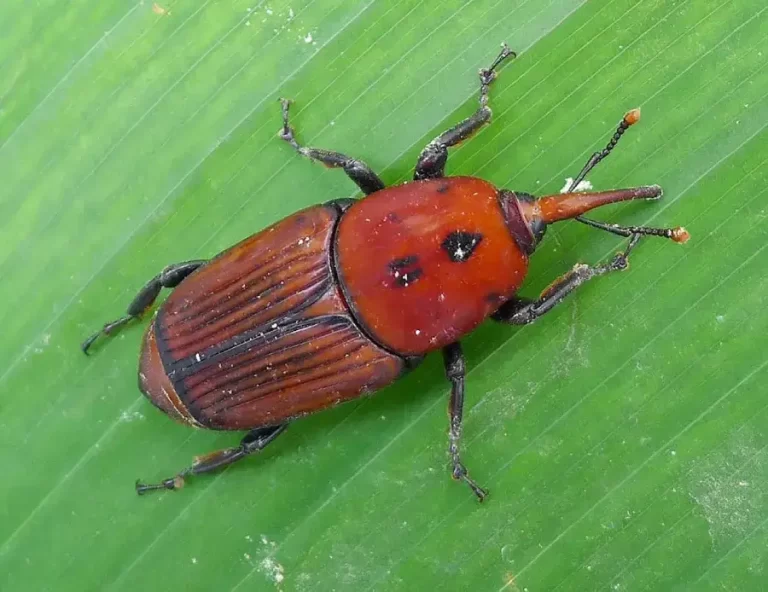When red palm weevil appeared in Greece?
The Rhynchophorus ferrugineus or red palm weevil, is without any exaggeration the most important enemy of palm trees, leading to their complete destruction. The red palm beetle was first identified in Spain in 1993, and arrived in our country in 2004 through contaminated plant material intended for the decoration of the Olympic Games. It was first detected in 2005 in Heraklion, Crete, according to reports from the Benaki Phytopathological Institute, with palms originating from Egypt.
Which palm trees are affected?
The ‘favourite’ palm of the red palm weevil is the canary (Phoenix canariensis), followed by the date palm (Phoenix dactylifera) and less so by the chamaerops (Chamaerops humilis) and the washingtonia. Unfortunately, experiments have shown that it can also attack the Theophrastus palm (Phoenix theophrasti), making the palm forest of Vai in Crete vulnerable.

How is the morphology of rhynchophorus ferrugineus?
Rhynchophorus belongs to the family Curculionidae and the order of the coelacanths. Females lay about 300 eggs, which are laid on the crown of the palm tree, but also in the axils of the leaves and on the trunk, where they hatch in 2-5 days. The biological cycle of the insect consists of four stages, the egg, the larva, the nymph and the larvae. The larva is up to 5 cm in size, with a white body, brown head and strong large jaws. Each larva, to protect itself, forms a cocoon from the dry fibres of the palm tree, in which it remains for 2 or 3 weeks. Similarly, the adult beetle is about 4 cm long and has a reddish-brown colour with some black spots and a distinct snout, hence its name. Of course, overlapping generations of the red beetle can coexist in a palm tree at all stages of the biological cycle.
It is important to stress that increased temperatures favour the growth and thus the spread of the beetle.
What are the symptoms in palm trees?
It is difficult to tell if a palm tree has been invaded by the caterpillar at the beginning of an infestation, as the damage done by the larvae is done internally in the crown, the heart of the palm tree. This is where the new vegetation is located, which is a rich source of sugars for the insect.
Typical, however, are the following symptoms, starting with mild infestations:
– The leaves have itchy edges or side edges.
– Holes at the base of the leaves, usually as large as a finger in diameter.
– In very advanced infestations, the new growth has dried up and the old growth has become bent, so that the palm has the appearance of an open umbrella.
– The final stage of the disease, where the meristem of the palm is now also dead, consists of all the above symptoms, with the tree’s leaves also drooping and a bad smell.
These also signal the complete destruction of the tree.
Which is the best treatment?
In order to take measures to combat the insect, we need to consider how advanced the infestation is. If it is advanced, it is recommended to cut the tree from the root and burn it in order to advance the disease to as few trees as possible. If, however, the palm is only slightly affected and there is no leaf bending, universal spraying is carried out, with emphasis of course on the crown. At the same time, for greater effectiveness in combination with the universal spraying, it is advisable to root spray.
Another way of control, which has shown very good results, is the injection of insecticidal nematodes into the heart of the palm. The nematodes, which visually resemble worms, kill the larvae of the rhizophores by entering through the openings created by the latter. This is a biological method that does not endanger other animals or humans and lasts for about a month after the first application. Furthermore, it has the advantage that over time, unlike chemical preparations which lose their potency, the nematodes multiply and thus increase their activity. Of course, it is advisable to use this biological method as a preventive measure. The injection of nematodes also helps in the fight against the Paysandisia archon, a butterfly-like insect that is destructive to the palm tree. Another way of prevention is the method of ‘endotherapy’, which is injections of azadirachtin placed around the trunk at various heights, depending on the type of palm tree, its height and diameter.
Finally, the use of pheromone traps (1 per acre) is recommended for monitoring the population in an area.
Tips for palm trees!
– Under no circumstances should palm trees be transferred from areas with insect infestations or weak trees that will later be susceptible to the insect.
– The heads of palm trees should be cleaned regularly to prevent the decay of dry leaves from progressing in these places, because this is where the beetle loves to lay its eggs. When cleaning, the leaves should be cut about 120 cm away from the base of the plant so that the larvae do not reach the trunk of the tree.
– It is advisable not to prune on days of high temperatures, when the insect is in full bloom, but from mid-December to mid-February. Subsequently, after pruning, preventive spraying against the red beetle should be carried out.

